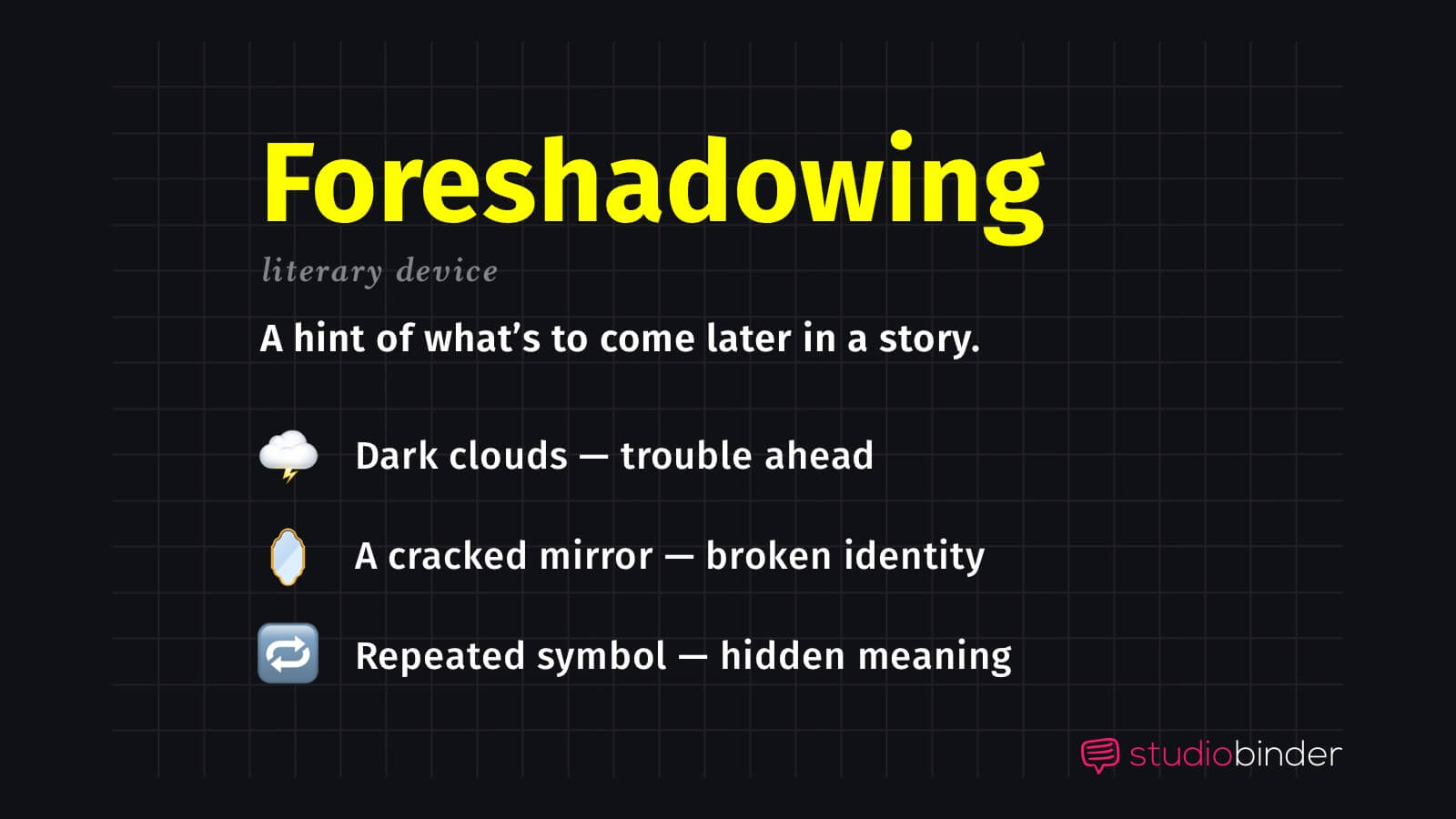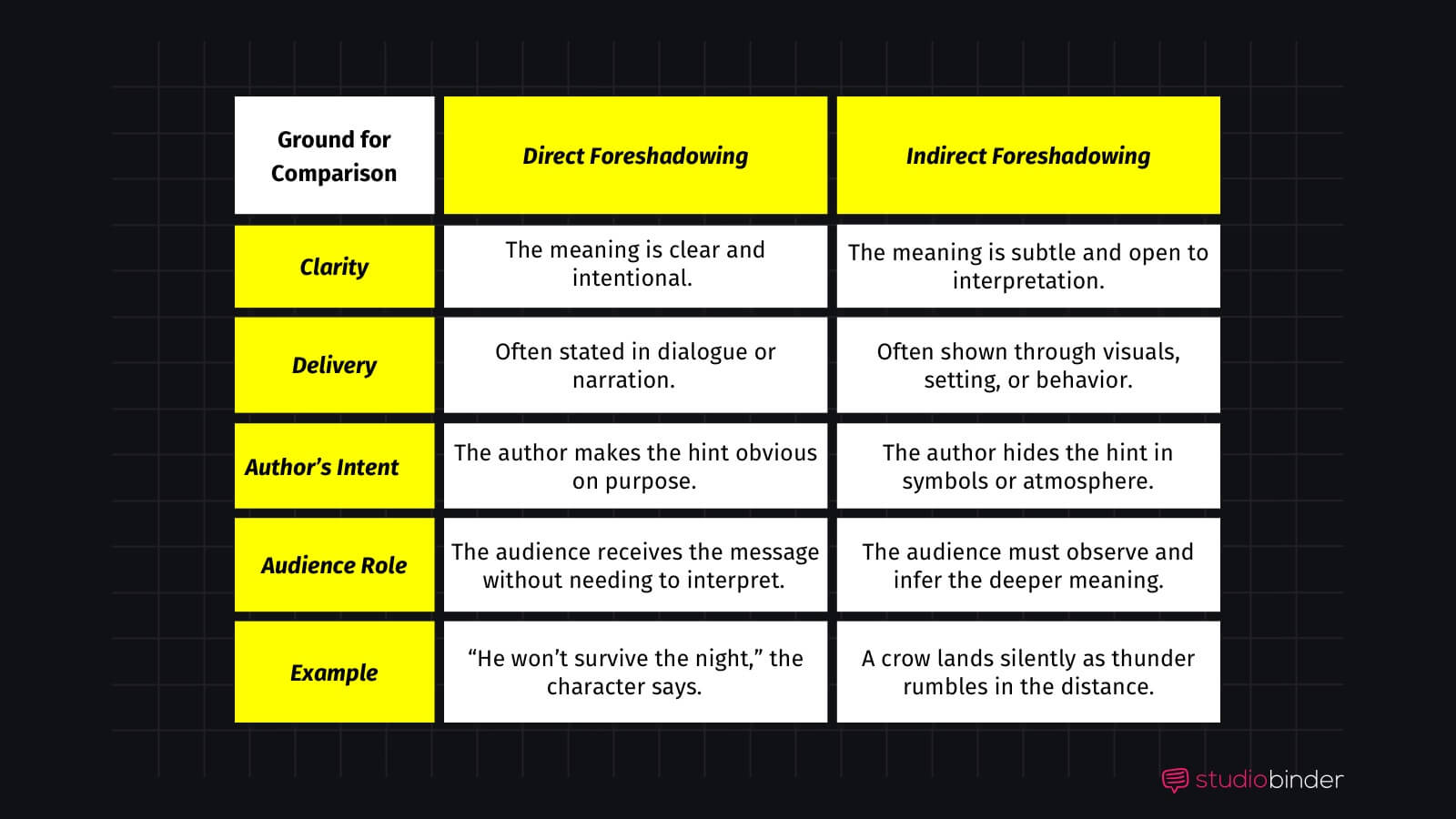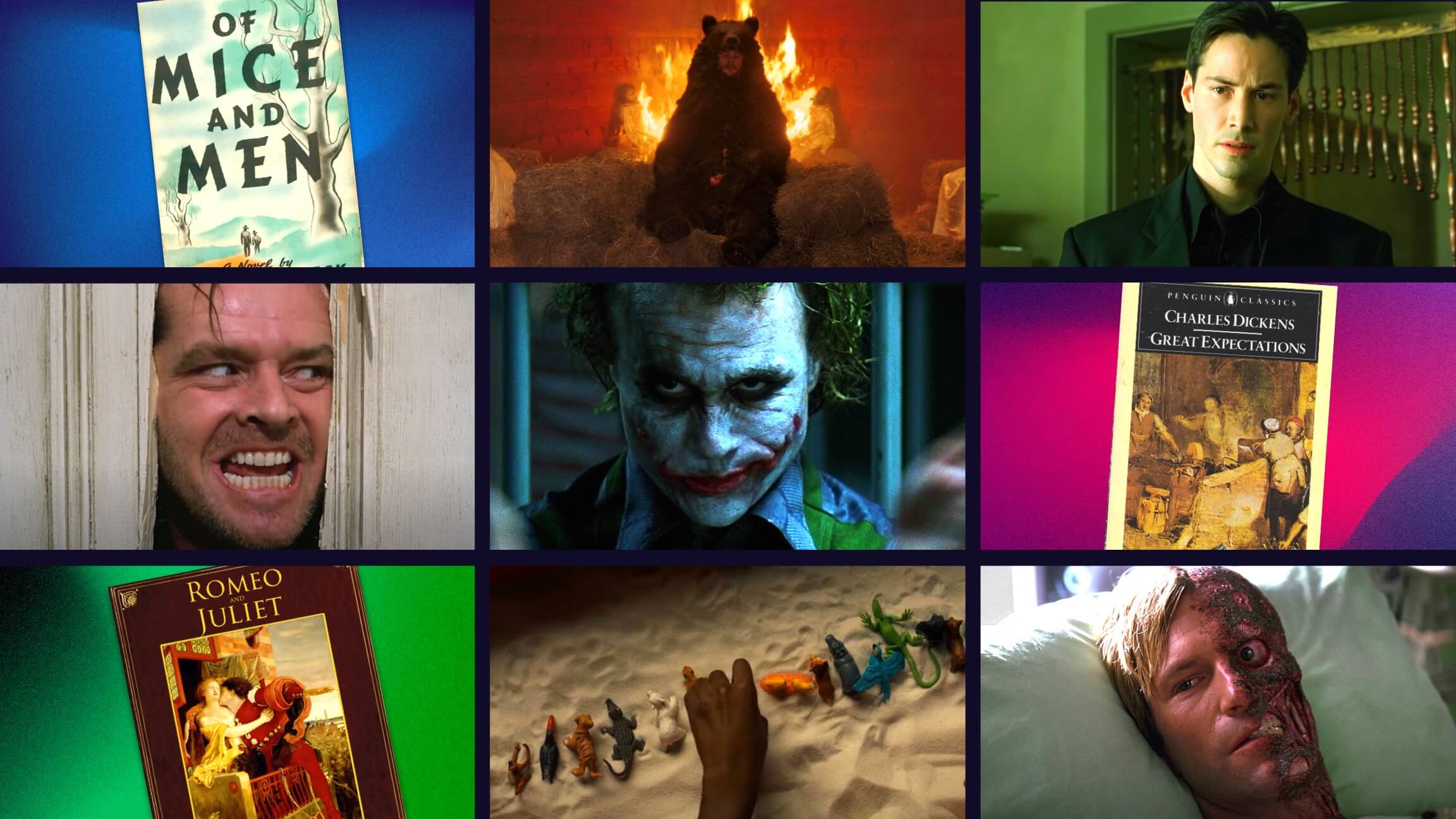Have you ever watched a movie with a plot twist that left you stunned, only to rewatch it and realize the subtle clues were there all along? This storytelling technique is called foreshadowing. But what is foreshadowing exactly? Is it merely dropping hints, or is it something more powerful? This article explores foreshadowing in literature and film, defining its types, analyzing famous foreshadowing examples, and revealing how master storytellers from William Shakespeare to Christopher Nolan use this device to craft unforgettable stories.
Watch: Two Types of Foreshadowing Explained
Foreshadowing Definition
Definition of foreshadowing
Before we examine foreshadowing examples in movies and literature, let’s establish a clear foreshadowing literary definition:
FORESHADOWING DEFINITION
What is foreshadowing?
Foreshadowing is a literary device that is utilized to give a hint or indication of future events in the story. It can be a very effective tool for developing curiosity, intrigue, suspense, and even narrative harmony at the end of a film or novel. Writers often introduce foreshadowing early in the story to set up a later event. An example of foreshadowing is when a minor event subtly hints at a major development later in the plot.
“Indicate” and “foretell'' are both foreshadowing synonyms. Although you can define foreshadowing in types based on how subtle or direct it is, the primary effect is to capture an audience's attention.
What is foreshadowing used for in storytelling?
- Creating suspense
- Dramatic build up
- Developing anticipation

Foreshadowing Definition and Examples
What Is Foreshadowing?
Direct vs. indirect foreshadowing
Now that you understand the foreshadowing definition in literature and film, you may think of some examples from filmmaking books or movies that immediately come to mind. All of those examples can generally be divided into two main categories:
1. Direct foreshadowing
This type explicitly signals future events. It often appears in dialogue, narration, or prophecy.
Example: In Hamlet, Marcellus ominously states, “Something is rotten in the state of Denmark.” This is an example of foreshadowing that signals the kingdom’s looming instability.
This openly implies that something is wrong with the Danish political hierarchy which is exactly what follows throughout the story arc.
It doesn't tell us what the exact problem is but this bit of direct foreshadowing lets us know that we will soon find out.
2. Indirect Foreshadowing
This is more subtle foreshadowing, where hints are woven into the story without outright revealing the outcome. It requires audience interpretation. A story element hints at upcoming events by leaving subtle context clues of what’s to come throughout the story. These hints are less on the nose and are usually only fully understood in hindsight or even during a second viewing or reading.
Example: In Star Wars: Episode II, Obi-Wan tells Anakin, “Why do I get the feeling you will be the death of me?” This line is another example of foreshadowing, as it seems casual but later proves to be prophetic; it foreshadows that Anakin (as Darth Vader) will later kill him.
While there may be two ways to define foreshadowing, both can be effective at achieving the same thing if done correctly. Capturing the audience's attention is at the heart of any use of this technique.

What is Foreshadowing • Direct Foreshadowing vs Indirect Foreshadowing
Related Posts
Examples Of Foreshadowing
Foreshadowing vs other devices
Foreshadowing can be confused with or can refer to, a whole handful of other literary devices. Let’s run through a couple of terms foreshadowing is typically associated with.
Foreshadowing vs Chekhov’s Gun
Chekhov’s Gun is a very famous type of foreshadowing. Referring to the works of playwright Anton Chekhov, the device simply states that a gun that shows up at the beginning of a story must be fired at the story’s end.
Watch to see how Knives Out masterfully uses Chekhov’s Gun, weaving clues throughout the story with precision and purpose. Pay close attention to the three key considerations—visibility, relevancy, and velocity—to understand how setup and payoff create satisfying storytelling.
Define foreshadowing • Knives Out
Of course, Chekhov’s Gun can be more widely applied. The point of the rule is that details you emphasize early in a story should come back into play later on. Remind you of something? That’s foreshadowing.
Foreshadowing vs red herring
A red herring is like the anti-Chekov’s Gun. Essentially, red herrings use audiences’ familiarity with foreshadowing against them. Say we see a gun hidden under a pillow in the first act– we’ll assume this is foreshadowing for a gun being used later on.
If the gun ends up being fake, or not used at all, it is a red herring. Red herrings are misleads– elements of a story that are meant to point us in one direction so we can be surprised later on.
Foreshadowing vs flash forward
A flash forward can be a form of foreshadowing, but it doesn’t have to be. If you want to define foreshadowing, it is best understood as a literary technique that hints at the future, whereas flash-forwards directly show events ahead. However, a flash forward can be vague enough that it operates as a hint.
Say we see a close-up of a gun being pulled out from under the pillow, but we don’t know by whom or for what purpose, and then we cut back to the events preceding the reveal. This is foreshadowing: we know the gun is going to come into play, but we don’t know how.
What Does Foreshadowing Mean
Why is foreshadowing important?
Before diving into its significance, let’s revisit the definition of foreshadowing—a literary device used to hint at future events, keeping audiences engaged by creating anticipation. Every story completely relies on the attention of the audience. The audience’s attention can be captured by keeping them in a state of anticipation.
This means not spoon-feeding them information all the time, but rather leaving clues to keep them guessing and interested in what’s to come.
Screenwriters use these clues to create suspense or a dramatic build-up for a reveal or plot twist. Without the setup, a story's big reveal can be much less impactful. This video dives into the idea that plot twists are more impactful only if it is properly foreshadowed.
Watch to see how the best plot twists use misdirection, breadcrumbs, and timing to create unforgettable cinematic moments. Pay close attention to how clues are subtly planted throughout a story, making the twist feel both shocking and inevitable in hindsight.
Define foreshadowing • The secret to writing compelling plot twists
The opposite of foreshadowing (leaving your audience in the dark to make your plot twist more shocking) is not nearly as effective.
What Is Foreshadowing?
Foreshadowing in literature
Before there was foreshadowing in movies, there was foreshadowing in books. Any type of writer can learn from some of the following examples.
Romeo and Juliet
Shakespeare most notably utilizes this technique in Romeo and Juliet when in the prologue he writes “A pair of star-crossed lovers…Doth with their death bury their parents’ strife.”
Shakespeare’s foreshadowing in Romeo and Juliet is extremely direct as it establishes the suspense of this doomed romance.
In another great example, Shakespeare uses foreshadowing throughout Romeo and Juliet. Romeo states, “Come, death, and welcome. Juliet wills it so.” This hints at his fate, subtly building suspense.
Juliet also has a vision of Romeo at the bottom of a tomb. That’s also foreshadowing that not-so-great things are coming.
Of Mice and Men
John Steinbeck foreshadows Lennie’s fate early on. A character remarks that weak creatures must be put down, subtly predicting Lennie’s tragic end. As the book progresses, George comes to believe that Lennie might fall under this description as well.
The Monkey’s Paw
The Monkey’s Paw also has a pretty dour ending, and it doesn’t come without a bit of foreshadowing. The story’s warning, “If you keep it, don’t blame me for what happens,” immediately foreshadows disaster, making the reader anticipate a grim outcome.
After seeing this, most readers will be on high alert for events to take a turn for the worse.
Now that you understand the importance of it, you might be wondering “What is foreshadowing in movies?”
After all, movies have more opportunities than literature to foreshadow events because it is such a visual medium. The foreshadowing definition remains the same, however, the techniques and implementation are different from literature.
Related Posts
Examples Of Foreshadowing
Foreshadowing in film
Unlike literature, movies use visual, auditory, and symbolic foreshadowing to create an immersive experience. Understanding the foreshadowing definition in film helps writers and directors craft unforgettable moments that reward attentive audiences.
Analyzing and breaking down some of these examples will help you find opportunities for this within your story that you may not have seen before.
Try to think of some films that have blown your mind with unforgettable plot twists. Odds are you can re-watch those films and find clues that the filmmaker left throughout the film that foreshadowed the twist. Without these clues, the plot twist would not have been as effective or memorable. Take a look at these six examples that each utilize a different facet of filmmaking.
If you've never seen No Country for Old Men, The Dark Knight, Fight Club, The Departed, The Usual Suspects, or The Prestige, this is your official and final spoiler alert.
Examples Of Foreshadowing In Coen Brothers Films
1. Place foreshadowing in the title
Sometimes, the title of a film itself can suggest a plot point of a film. It is important to be vague enough so that it entices curiosity in an audience before watching and only makes sense after the end credits. The Coen Brothers do this perfectly in their 2007 film No Country For Old Men.
What does foreshadowing mean in the title No Country for Old Men? The title was created by the novel's author Cormac McCarthy to allude to the fact that Ed Tom Bell (Tommy Lee Jones) is not cut out for this new generation of crime he is encountering.
The title of the film foreshadows that he cannot stop Anton Chigurh (Javier Bardem) in time to save Llewelyn Moss (Josh Brolin). The final scene of the film has been the subject of much debate mainly because it is a description of Ed Tom Bell’s dream after he fails to save Llewelyn and retires as a sheriff.
What does foreshadowing mean? • No Country for Old Men
When juxtaposed with the title, Ed Tom Bell’s dream can be interpreted as the path that he thought would lead him to succeed as a sheriff. Little did he know that following the lessons of his father would do him no good in a new generation of crime, a world in which he cannot keep up.
Examples Of Foreshadowing In Superhero Movies
2. Include foreshadowing in dialogue
“You either die a hero, or live long enough to see yourself become the villain.” What is foreshadowing in that dialogue? The answer depends not only on what is said but also on who says it. The first half of The Dark Knight builds up Harvey Dent as this unmasked hero that Gotham needs.
He is very much a symbol of justice as we enter this scene. The implications of Harvey saying this quote is not clear until he later becomes Two-Face.
Foreshadowing meaning • The Dark Knight
The quote is memorable, yet its impact resonates more the moment Harvey Dent becomes evil. The line is a brilliant use of indirect foreshadowing because it does not directly allude to the fact that Harvey Dent becomes a villain, yet it foreshadows in retrospect.
Foreshadowing Examples in Thrillers
3. Present foreshadowing in narration
“When you’re suffering from insomnia, nothing’s really real.” Fight Club has one of the most notorious plot twists in recent cinema.
If you’ve ever given it a second or even third watch, you may notice the subtle clues sprinkled throughout the film that foreshadow Tyler Durden (Brad Pitt) not being real.
One of the biggest red flags is The Narrator (Edward Norton) acknowledging that nothing is certain when you’re suffering from insomnia. Notice in this clip what happens when he says this.
Definition of foreshadowing • Fight Club
Did you catch that? That flash, if paused on, foreshadows the plot twist of the entire film. It is Tyler before the Narrator even forms a relationship with him. Blink and you'd miss it during the first watch, but once you see it again, it is a mind-blowing moment of foreshadowing.
Foreshadowing Examples in Scorsese Films
4. Add symbols for foreshadowing
If you’ve ever seen The Departed, you know that the film is full of twists and turns that kill off nearly all of the main characters, but did you know that director Martin Scorsese left very clear clues as to which characters were going to die? Scorsese borrows from the playbook of Scarface (1932) and places an “X” within the frame of a character that dies throughout the film.
Foreshadowing meaning • The Departed
Some X’s are more direct while others are more subtle. Nonetheless, the X is always there. This use of symbolism becomes even more apparent with a second watch of the film because they usually appear in the moments leading up to death.
Foreshadowing Examples in Crime Dramas
5. Use characters as foreshadowing
This classic “whodunit” film leaves the audience curious and engaged until the very last minute. How? The Usual Suspects brilliantly balances subtle, indirect foreshadowing throughout the movie with a rapid-fire direct foreshadowing scene that puts everything together. The result is a plot twist that still ranks among the best more than twenty years later.
Foreshadowing meaning • Verbal Kint’s Story
This incredible closing scene has been duplicated and parodied for years after its release largely due to its effective method of bringing all the clues together to end a story.
Foreshadowing Examples in Christopher Nolan Films
6. Use foreshadowing through action
As a film bursting perfectly exemplifying the foreshadowing literary definition, Christopher Nolan's The Prestige is a great example of incorporating just enough to keep an audience engaged and just short of giving away its huge plot twist.
One of the scenes that blows your mind upon a second watch is when Alfred performs his bird cage trick in which he kills a bird and brings it back to life.
This video breaks down the scene and how Nolan manages to leave clues to the film's plot twist in plain sight.
What is foreshadowing? • The Prestige
It can often be difficult to foreshadow through action, but Christopher Nolan takes advantage of the unique quality that magicians have in showing rather than telling and utilizes it to create a scene that only gets better with a second watch.
Foreshadowing is one of the most effective tools filmmakers have at creating curiosity in an audience and thus capturing their attention. However, it is important to understand how much and what type your story calls for.
Too much could create a predictable story that the audience disengages from. Too little and it might become boring or confusing and also disengage them. Try finding moments in your story to engage some of these foreshadowing techniques and see what works for you.
Related Posts
What Is Foreshadowing?
Final thoughts & next steps
A strong definition of foreshadowing helps writers effectively integrate it into their storytelling. Foreshadowing is an essential tool that keeps audiences engaged by building suspense and anticipation.
The key is balance—too much can make a story predictable, while too little can make twists feel unearned.
How to Apply Foreshadowing in Your Writing
- Study the Best – Rewatch a movie or reread a book with a major twist.
- Spot the Clues – Identify dialogue hints, visual symbols, or repeated motifs leading up to the reveal.
- Enhance Your Story – Plant subtle foreshadowing in your own writing to create deeper engagement.
- Take Action – Try adding subtle foreshadowing to your next project and see how it transforms your storytelling.
From classic literature to modern cinema, foreshadowing shapes the way audiences experience a story. It creates tension, deepens meaning, and rewards attentive readers and viewers. Whether you’re crafting a novel, screenplay, or short story, mastering this technique will make your narratives more compelling and unforgettable.
Up Next
Explore more literary devices
Foreshadowing is just one of many literary devices and types of figurative language, including exposition, allusion, and symbolism. If you're a writer and want to develop your craft fully, do yourself a favor and continue this exploration. The next article on literary devices is a gateway to many of these tools that help add substance and style to any type of written work.
